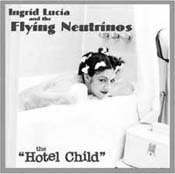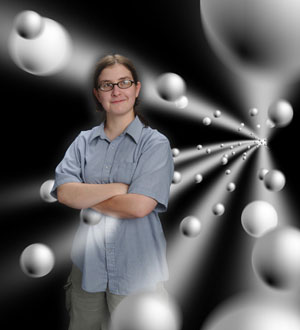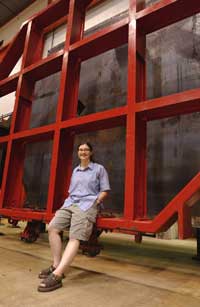 |
|
Flying Without a Net by Pamela Zerbinos
Two of the band’s members have been Neutrinos most of their
lives. The lead vocalist and her brother, a tap-dancing trombone
player, are the oldest children of a musical pair of socially
conscious adventurers whose family band was called the
Flying Neutrinos. When the oldest children split in the mid-90s,
they took the name with them, and the remaining family
members became the Floating Neutrinos.
“Neutrinos,” say the Neutrinos, “are subatomic particles that
exist throughout the universe, invisible but ever-present,
and act as a sort of balancing factor to all visible matter.
The neutrino is a symbol of all the unseen but
nevertheless real parts of ourselves and the universe,
which must be taken into account if we are to become whole and
fully manifested.”
My background doesn’t offer much of a starting point. I arrived at
Northwestern University with thoughts of double-majoring in journalism
and mathematics. I thought science coverage—especially “hard” science
coverage—was abysmal, I was madly in love with calculus, and combining
the two sounded like a great idea.
Predictably, I veered off-course. Although I stuck to
journalism, my second major switched four times
before settling on European history. My specialty,
if you can call it that, was the papacy. I know a lot
about popes and politics (and even papal politics),
but not very much about particles or physics or
particle physics.
I went on to get my Master’s degree in journalism
from Northwestern, where I took a science writing
class, which came on a field trip to Fermilab, which
was arranged by the Public Affairs Office, which
was looking for a summer intern. So, after a
winding but eventually circular path, I find myself
back to writing about science. My first task: figure
out this neutrino thing.
The first stop on My Personal Neutrino Adventure,
as I begin to think of it, is Fermilab’s website. From
this, I learn that neutrinos are incredibly elusive,
“ghostly particles” that travel throughout the
universe “without leaving a trace.” Throughout
the 70-year history of the neutrino, it has been at
the center of a host of mysteries, some of which
remain unsolved. Most neutrino literature has
names like, “The Case of the Missing Neutrinos”
and “A Subatomic Detective Story.” I start having
black-and-white visions of Humphrey Bogart,
chomping a cigar, interrogating physicists about
the missing particles, the keys to larger mysteries
and higher understanding.
I need to know
more. I don’t
understand how
to count particles
that leave no trace.
I don’t understand
where you get them
or how you make them.
(Is there some kind of
neutrino factory? When I find out
exactly such a thing may be in the
works, I am giddy. I have visions of Willie Wonka’s
Chocolate Factory, with Oompa-Loompas carrying
around baskets of brightly colored neutrinos, all
carefully labeled “electron,” “muon” and “tau.”) In
the case of a long-baseline neutrino experiment
like MINOS, how do you know the neutrinos
arriving in Minnesota are the same ones that left
Fermilab? I am particularly baffled by this phrase,
which pops up again and again: “new physics
beyond the Standard Model.” What is “new
physics”? Is it like “new math”? I always thought
that was a joke my parents used to get out of
helping me with my algebra homework.
I set off on My Neutrino Adventure, intent on finding
some answers. Help arrives quickly, although from
an unexpected quarter: my mother. During our
weekly phone call, I happen to mention something
about neutrinos. Excitedly, she says, “I know what
neutrinos are!” I can practically see her bouncing
up and down. I swallow my surprise, and wait for
her to continue.
“They’re energy
sources from the
sun,” my mother
explains.
“By measuring
the different kinds
of neutrinos and how
many there are, they
can tell how hot the sun is.”
She pauses. “Or...something
like that.”
She points me in the direction of a poorly executed
story by her local NPR affiliate about the Sudbury
Neutrino Observatory and its latest results. I head
to SNO’s site, and then make a quick list of the
neutrino facts I have gathered on my adventure:
Neutrinos are elementary particles with no charge.
There are three types of neutrinos—electron, muon
and tau. Most were produced in the Big Bang, but
some show up in cosmic-ray showers, some are
produced in the sun’s core during fusion reactions
and still others are given off during radioactive beta
decay. For a long time, they were thought to be
without mass, and the Standard Model does not
account for a massive neutrino. Nor does the
Big-Bang theory, or the theory about universal
expansion. But recent experiments have found
hints that neutrinos can oscillate—change from
one type to another—and SNO seems sure that
it’s got definitive proof. And if neutrinos oscillate,
they have mass.
I panic, and here’s why. I’m one of those people
who suffers from an overactive imagination, and
in my head, it works like this: Someone discovers
that a fundamental idea of physics—say, gravity—
doesn’t work the way we thought it did. Furthermore,
we have no idea how it works, and this
changes everything. None of our math works now.
Suddenly, by merely uttering that statement, reality
reflects the new uncertainty. Not only does none of
our math work, but gravity itself no longer works.
Books fly off the shelves. People float around,
bumping their heads on ceilings, which are themselves
coming apart. There is a run on jet packs.
True, a massive, oscillating neutrino will solve a
lot of mysteries. Neutrino mass may account for
some of the mysterious dark matter in the universe.
Neutrino oscillations explain “the missing solar
neutrinos”—the mystery of why, when counting
neutrinos from the sun, only about one-third as
many show up as the theories predict.
But the cosmologists’ equations for the first few
minutes of the universe use a massless neutrino.
As do the astrophysicists’ equations showing
the universe will expand indefinitely. And so, if
neutrinos have mass (which they do), and that
mass is found to be sufficient for the universe
to eventually collapse back in on itself (which it
probably is), then clearly that collapse is going to
happen soon. Like next Tuesday. Hence my panic.
I head to the cafeteria, intent on grabbing a
physicist—any physicist—and accosting him with
questions like, “What are we going to do about
this?!” Suddenly, I am stopped in my tracks by
a comforting thought: the Plum-Pudding Model.
To my knowledge, the world did not spin out
of control, or explode, or cease to exist, when
J.J. Thomson’s old model about atom composition
was disproved. Granted, that’s comparing apples
and oranges, but I try not to think about that. I go
back to my desk, deciding, for the sake of my
mental health, to finish my neutrino reading.
The Public Affairs library, conveniently located
about four feet from my desk, is home to several
helpful volumes. I grab “The Elusive Neutrino”
by Nickolas Solomey, “Spaceship Neutrino” by
Christine Sutton and “The Case of the Missing
Neutrinos” by John Gribbin. I talk to neutrino
physicists. I go to a lecture called “Neutrino
Physics at Fermilab,” for which I am overdressed,
and after which I call the lecturer (a very helpful
Peter Shanahan) for more details. I ask him
intelligent questions like, “What’s with that?”
He indulges me for quite some time, and then
says, “Maybe you should talk to a theorist.”
I do, and eventually, a picture starts to emerge.
But just as I start to wrap my mind around it, it
shatters into a million different pieces, a million new
questions, each more complicated, perplexing—
and philosophical—than the last.
The latest batch: Can neutrinos spin in either
direction? (The short answer—yes—confuses me
even more than parity violation, because, despite
the valiant efforts of the theorist Boris Kayser, I
don’t see why the angle from which you’re viewing
the neutrino should change the direction in which
it’s spinning. I just don’t.) How can a particle be its
own antiparticle? Are there really just three types
of neutrinos? In what ways do they mix? Why are
they so light? How long do they live? What’s a
spinor? (I picture a spiky armadillo, but apparently
it’s some kind of mathematical construct.)
My confusion and I are in good company.
"It's like wallowing in an intellectual mud bath," says Boris, after very generously attempting to
explain to me for nearly two hours just how a
particle can be an antiparticle of itself. After our
talk, I spend 45 minutes staring
at a wall, trying to decide if I
understand or need to go back.
That answer is one that comes
quickly. Of course I’ll need to
go back. I will always need to
go back. Even the physicists
need to go back, which is
precisely what makes neutrinos
so fascinating. Neutrinos are
both telescope and microscope,
able to take us out to the
farthest reaches of the universe
and into the very heart of
matter. They can shed light
on how particles acquire mass,
what the universe is made of,
and why there is more matter
than antimatter (which is too
bad—I must admit to liking the
idea of an anti-Pam, except for
the annihilation part). Neutrinos
can be a wonderful probe into
the weak force, into flavor, into
the structure of the nucleon. There are countless
neutrino adventures to be had, countless physics
adventures to be had, and I hope to leave Fermilab
better able to communicate the excitement of those
adventures to the outside world. I’ll just need a few
more weeks to work on this neutrino thing.
—Pamela Zerbinos is an intern in Fermilab’s
Office of Public Affairs.
On the Web:
|
 On May 3 of this year, Ingrid Lucia and the Flying Neutrinos took
the stage at the New Orleans Jazz & Heritage Festival, an annual
two-week long party that draws more than half a million people.
The Neutrinos, a quirky six-person band out of New York that mixes
jazz, swing, blues and soul, were making their second appearance.
On May 3 of this year, Ingrid Lucia and the Flying Neutrinos took
the stage at the New Orleans Jazz & Heritage Festival, an annual
two-week long party that draws more than half a million people.
The Neutrinos, a quirky six-person band out of New York that mixes
jazz, swing, blues and soul, were making their second appearance. And that’s what I knew about neutrinos the day I reported for work at
Fermilab. Clearly, there was work to be done.
And that’s what I knew about neutrinos the day I reported for work at
Fermilab. Clearly, there was work to be done.
